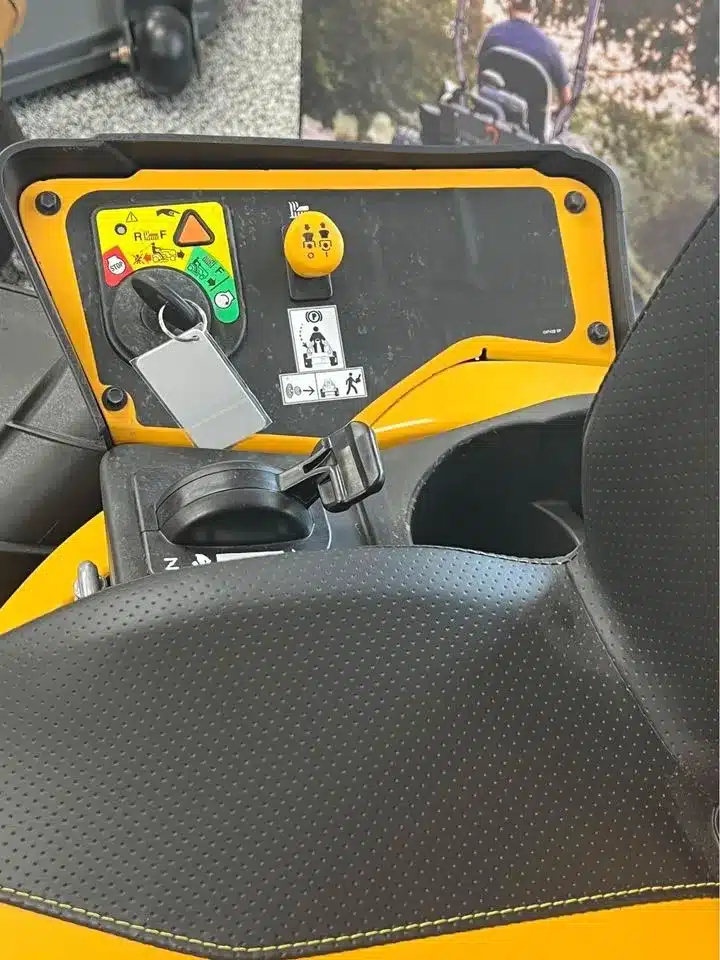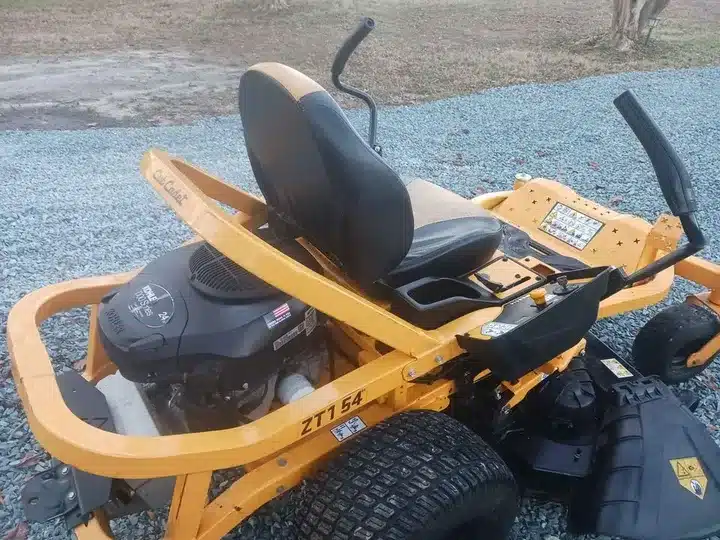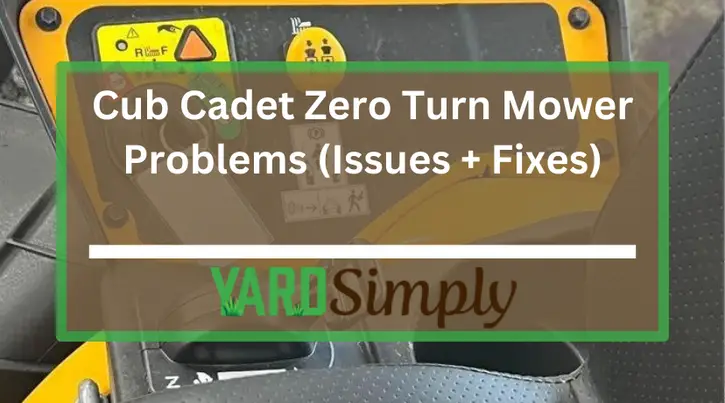As a seasoned expert with years of experience in handling and resolving Cub Cadet zero turn mower problems, I bring to you a comprehensive guide filled with practical solutions.
My hands-on knowledge and technical understanding of these machines equip me to offer you effective and efficient troubleshooting tips.
Trust in my expertise as we delve into identifying and fixing common issues, ensuring your mower’s optimal performance. Let’s dive right in, addressing these challenges head-on with clear, actionable advice.
Key Takeaways
- Common problems with Cub Cadet zero turn mowers include starting difficulties, unexpected shutdowns, engine smoke, weak hydrostatic transmission, steering issues, and uneven cuts.
- Troubleshooting techniques include inspecting safety switches, transmission fluid, and drive belts to address issues like sudden stops, weak hydrostatic transmission, and steering problems.
- Well-maintained Cub cadet zero turn mowers are statistically less likely to encounter severe problems and tend to have a longer lifespan.
- In my experience, investing time in routine maintenance and understanding the mower’s mechanics ensures reliable performance and a beautifully maintained lawn.
Top Cub Cadet Zero Turn Mower Issues + Fixes
I’ve run into my fair share of issues with my Cub Cadet zero turn mower, and I’ve learned a thing or two about troubleshooting.
From the frustration of a mower that won’t start to the surprise of it stopping mid-cut, I’ll walk you through some common problems and their fixes.
- Mower Won’t Start & Mower Difficult to Start
- Mower Suddenly Stops
- Mower Producing Smoke
- Weak Hydrostatic Transmission
- Mower Won’t Steer Straight or Correctly
- Mower Not Moving
- Mower Vibrating
- Uneven Cut
- Gas Leaking
Related: Gravely Zero Turn Mower Problems: Troubleshooting Guide
1. Mower Won’t Start & Mower Difficult to Start

When you turn the key on your Cub Cadet zero turn mower and are met with silence or difficulty in starting, it often indicates a problem that can range from simple to complex.
Initially, I check the basics: ensuring fresh fuel in the tank and a fully charged battery. These are common culprits, but sometimes the issues are more intricate, involving ignition system malfunctions or fuel delivery problems.
Cleaning or replacing spark plugs and air filters can often rectify these starting difficulties. Safety switches, designed for protection, can sometimes be finicky and contribute to the problem.
Dirty air filters or a clogged carburetor are also not uncommon causes of starting troubles.
If the simple checks don’t yield results, I delve deeper into the mower’s electrical system, inspecting for corroded terminals or a dead battery.
After systematically troubleshooting and addressing these issues, the mower usually starts up smoothly again. Regular maintenance is key to circumventing these start-up challenges.
Learn More: Husqvarna Zero Turn Won’t Start: Solutions
2. Mower Suddenly Stops
Occasionally, a Cub Cadet zero turn mower may come to an unexpected halt mid-job, signaling a problem that requires immediate attention.
When this happens to me, I first check the basic culprits: fuel levels, air filter blockages, and battery connections. It’s not uncommon for a mower to stop if it’s running on empty or the filter is clogged.
Also, loose battery cables might disrupt the power supply.
If those aren’t the issues, I look at the safety switches. A disengaged seat or control arm switch can cause a sudden stop. I make sure I’m seated properly and the arms are in the correct position.
If it’s still a no-go, I know it’s time to delve deeper, possibly into the fuel system or electrical components, which might need an expert’s touch.
3. Mower Producing Smoke
A plume of smoke billowing from a Cub Cadet zero turn mower is a surefire sign of trouble that demands swift action. When I’ve seen smoke, my first step is to turn off the engine immediately to prevent further damage.
It’s usually a sign that the mower is burning oil. This could be due to overfilling the engine oil or a more serious issue like a leaking gasket or a problem with the piston rings.
I’ll check the oil level first, and if it’s too high, I’ll drain the excess. If the oil level’s fine, I know it’s time to inspect the engine for leaks or other wear signs.
Occasionally, it’s just accumulated debris or a clogged air filter causing the engine to overheat and smoke, both of which are easy fixes.
Also Read: Bad Boy Mower Smoking: Quick Fixes
4. Weak Hydrostatic Transmission

Several Cub Cadet zero turn mower owners have reported issues with weak hydrostatic transmissions, which can manifest as reduced speed or a lack of response when accelerating.
I’ve found that this problem can often stem from a lack of transmission fluid or old fluid that needs replacing. It’s crucial to check the fluid levels and quality regularly.
If the fluid’s fine, the issue might be air trapped in the system, which requires purging to restore full transmission power.
I also make sure to inspect the drive belt for wear and tear, as a damaged belt can significantly affect the mower’s performance.
If these checks don’t resolve the problem, it might be time to consult a professional or consider a transmission rebuild or replacement.
Related: Cub Cadet Zero Turn Hydrostatic Problems and Solutions
5. Mower Won’t Steer Straight or Correctly
When your Cub Cadet zero turn mower starts veering off course or won’t steer straight, it’s often due to misaligned tracking or worn steering components.
I’ve found that checking the tire pressure is a good first step—uneven pressure can cause pulling to one side. If that’s not the issue, I look at the steering levers. They should be even and adjusted correctly for responsive steering.
If the problem persists, I inspect the linkage for wear or damage. Replacing any worn parts is crucial.
Lastly, I make sure the drive system is properly lubricated; a lack of lubrication can lead to steering difficulties.
Regular maintenance and addressing these issues promptly usually get me back to mowing straight in no time.
6. Mower Not Moving
Encountering a Cub Cadet zero turn mower that refuses to budge demands immediate attention to the drive system components.
First, I check the basics: are the parking brakes disengaged, and is the drive release lever set correctly?
If that’s not the issue, I’ll inspect the drive belt for any signs of wear or damage. A snapped or slipped belt won’t transfer power from the engine to the wheels.
If the belt’s intact, I’ll move on to the hydrostatic transmission fluid level. Low fluid can prevent the mower from moving, so I’ll top it up if needed.
Lastly, I’ll look for any obstructions that might be jamming the drive system. Clearing debris and ensuring all parts are free to move usually gets me back to mowing again.
7. Mower Vibrating
A vibrating Cub Cadet zero turn mower often indicates an imbalance or loose component within the machine. I’ve found that it’s usually a sign that something’s amiss, and I tackle it by checking for a few common culprits.
First, I make sure the blades are sharp and balanced; a dull or uneven blade can cause significant vibration.
If that’s not the issue, I’ll move on to inspect the spindle bearings and pulleys for wear or damage.
Sometimes, it’s just a matter of tightening loose bolts or nuts, especially those connecting the deck to the frame.
If all else looks good, I’ll check the engine mount, as a loosened mount can also lead to excessive shaking.
Usually, one of these fixes will smooth things out.
8. Uneven Cut
Dealing with an uneven cut from your Cub Cadet zero turn mower can be frustrating, but it’s often a fixable issue with the right approach.
First, I check the tire pressure because uneven tires can lead to an inconsistent cut. If that’s not the culprit, I examine the mower deck for levelness. Adjusting it to the correct height usually does the trick.
Next, I inspect the blades. Dull or damaged blades can’t cut grass effectively, leading to a patchy lawn. I make sure they’re sharp and replace them if necessary.
9. Gas Leaking
Gas leaks in a Cub Cadet zero turn mower can pose significant problems, but they’re typically traceable to a few key areas and are repairable with some basic troubleshooting.
First, I always check the fuel lines for cracks or loose connections. It’s not uncommon for these lines to wear out over time, leading to leaks. If I find a damaged line, I replace it immediately.
Next, I examine the fuel tank for any signs of damage or corrosion that might cause leakage. A simple patch or tank replacement can solve this issue.
I also pay close attention to the carburetor, as a stuck float or bad gasket can lead to fuel escaping. Generally, a carburetor rebuild kit is all I need to fix such problems and prevent gas from leaking out.
Maintenance Tips
Regularly checking and replacing the oil in your Cub Cadet zero turn mower is crucial for ensuring its longevity and optimal performance.
I make it a point to follow the manufacturer’s schedule for oil changes and choose the right type of oil for my mower’s engine. This simple act can prevent a multitude of issues down the line.
I also keep an eye on the air filter because a clean air filter means my mower’s engine breathes easier and runs more efficiently.
I clean it regularly and replace it when it shows signs of wear. It’s a small task that can have a big impact on the mower’s functionality.
Sharpening the blades is another essential maintenance tip I’ve learned. Dull blades tear the grass rather than cutting it cleanly, which can lead to an uneven lawn and put unnecessary strain on the mower.
I check the blades periodically and sharpen or replace the blades as needed.
Lastly, I always inspect the tires for proper inflation and the belt for signs of wear. Consistent maintenance like this keeps my Cub Cadet zero turn mower running smoothly and helps me avoid many common problems that can arise from neglect.
Our Verdict
In wrapping up, I must say that my journey with the best Cub Cadet zero turn mower has been quite enlightening. Regular maintenance, like checking the oil and keeping those blades sharp, has been a game-changer for me.
It’s true, a little bit of care goes a long way in avoiding common issues like starting troubles or uneven cuts. I’ve tackled a range of problems, from steering glitches to mysterious smoke, and each fix has added to my knowledge and confidence.
Remember, staying ahead with routine checks and timely repairs really does pay off. Whether you’re dealing with slopes or just maintaining a pristine lawn, this mower, in my experience, stands up to the task impressively.
So, happy mowing, and trust me, a well-kept Cub Cadet zero turn mower will not let you down!
Frequently Asked Questions
What are the environmental impacts of using a Cub Cadet zero turn mower, and how can I minimize them?
I’m concerned about emissions and noise pollution from my mower. To minimize these impacts, I’ll maintain it regularly, use it efficiently, and consider switching to a more eco-friendly electric model.
How does the performance of a Cub Cadet zero turn mower compare to traditional lawn tractors when dealing with uneven terrain or slopes?
I’ve found that my zero turn mower handles uneven terrain more efficiently than traditional lawn tractors, offering better maneuverability on slopes, though it requires careful handling to maintain stability and prevent tipping.
Are there any specific safety accessories or gear recommended when operating a Cub Cadet zero turn mower?
I recommend wearing a helmet, gloves, and eye protection when operating my Cub Cadet zero turn mower. They’re essential for safety, especially if I’m dealing with debris or steep inclines.
Can the Cub Cadet zero turn mower be used for commercial landscaping purposes, and if so, what are the long-term durability expectations?
I can use the Cub Cadet zero turn mower for commercial landscaping, but I’m curious about its long-term durability since that’ll impact my investment and maintenance costs over time.
How does the use of a Cub Cadet zero turn mower affect the overall health and appearance of the lawn compared to manual or robotic mowers?
I’ve found that using a zero turn mower gives my lawn a clean, even cut, which improves its health and appearance over manual or robotic mowers that might miss spots or be less precise.


